Final knowledge is already there but not recognized
The usual way of teaching a subject is to build up information to higher and higher levels, each resting on the lower ones, which cannot be dispensed with. It could be called Teaching Up.
But there is another method, Teaching Down, for cases where the final knowledge is already there but not recognized. The method is used extensively in the Gītā, and by Śaṅkara following the Gītā. In the Gītā as a whole, first the highest truth of the Self is presented. It is not accepted by Arjuna (as is shown in IV. 4 when he queries the immortality of the Self). Now karma-yoga is given, in very uncompromising form. It has three main elements: (1) enduring patiently the pairs of opposites; (2) performing well directed skilful actions with evenness of mind in success or failure; (3) bringing the mind to complete one-pointedness in samādhi meditation. The whole programme is set out in Chapters II and III. Nothing is said here about devotion to the Lord.
This austere karma-yoga too fails to set Arjuna moving towards freedom from his grief and delusion, and chapters IV onwards gradually begin to introduce worship of the Lord in various aspects, mostly of an auspicious kind. By chapter X Arjuna thinks that he has realized truth. But then he asks for, and is granted, the vision of Chapter XI, the Lord as the spirit upholding the Universe, with both auspicious and inauspicious attributes. It proves to be too much for Arjuna as he stands. The Gītā begins again, so to say, with the highest truth and the Knowledge-path. At the end, however, the worship of the Lord is set out to Arjuna again.
The basis of the Teaching Down method is that there is already a submerged intuition of the truth, which has to be stimulated by increasingly detailed instructions. The aim of the instructions is not to give information but to awaken the half-sleeping knowledge.
Plato supplies an example of the method in Western teaching, though what he wants to illustrate is not quite the same.
1.An uneducated slave is presented with a drawing of a square.

2.He is asked to suggest a method of making another square, double the size of this one. His first thought is to double the length of the sides.
3.This is done, and he is shown how it results in a square four times the original one – consisting in fact of four of them.
4.
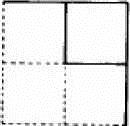
5.It is suggested to him that if each of the squares could be halved, and the halves could make up a square, that new one would be twice the size of the original square.
He does not see how to halve a square. A diagonal line is drawn, and he agrees that this halves the square. The shaded area is half the size of the original square.
6. Another of the squares is halved with a diagonal line. Perhaps he now says:
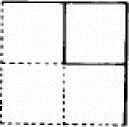
‘I see it, I see.’ If not. . .
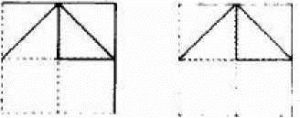
7.Another diagonal line is drawn
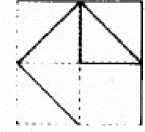
8.If he still does not see, the last one is drawn. If necessary, it is further explained how the shaded square must be double the original square, because it consists of four halves
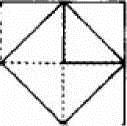
9. At the very end, the extra lines and shadings are rubbed out, and the required square stands out clearly.
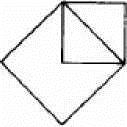
After a time, longer or shorter, he suddenly sees it. Some will have seen it well before this.
It is not a question of learning. The additional lines and shading are not things to be learnt. Nor is it a question of other extra knowledge. Even someone familiar with the theorem that the square on the hypotenuse is equal to the sum of the squares on the other two sides might not see its relevance to the problem of constructing a new square with double the area. The additional lines are to stimulate the intelligence which will ultimately ‘see’. The student must not be allowed to think that he is supposed to be learning the new lines; he has to be reminded periodically that the aim is to find a new square.
It is not a question of learning. The additional lines and shading are not things to be learnt. Nor is it a question of other extra knowledge. Even someone familiar with the theorem that the square on the hypotenuse is equal to the sum of the squares on the other two sides might not see its relevance to the problem of constructing a new square with double the area. The additional lines are to stimulate the intelligence which will ultimately ‘see’. The student must not be allowed to think that he is supposed to be learning the new lines; he has to be reminded periodically that the aim is to find a new square.
In a rather similar way, the Gītā first declares the supreme Self, the solution to all grief, hankering and delusion. Arjuna cannot find it in himself; his mind is too disturbed.
So yoga practice is presented to him: calm endurance, acting efficiently but unaffected by results, and samādhi meditation. This is to lead to Knowledge. The process of stabilizing that Knowledge is described – mainly detachment and meditation. This completes the exposition of the path to release (IV.3). Nothing has been said about the Lord as projecting the universe by magic power-of-illusion (Māyā), or about devotion to Him. These are implicit in practice of full realization of the Self, and do not need to be explained separately. It is a fathomless wonder (II.29).
But when Arjuna does not see, Chapters IV and V begin to hint at the Lord as director of the universe, and well-disposed to men, though projecting the divine magic show in which many are deluded.
Karma-yogic action is explained in more detail, but the ideal is also expressed again and again: I do nothing at all – thus should the truth- Knower meditate, though to outward appearances engaged in walking and other actions. Chapter VI gives directions for samādhi, and from VII on there are many declarations of the truths to be meditated upon. In IX and X devotion to the Lord comes in a great flood.
These things can be compared to the extra lines and shadings in Plato’s example. They are not always essential, but they do lead to the final realization, in which they can disappear.
Śaṅkara in his commentary frequently makes his explanations in terms of the Gītā teaching method: presenting provisional extra indications where necessary, which later disappear in the full truth